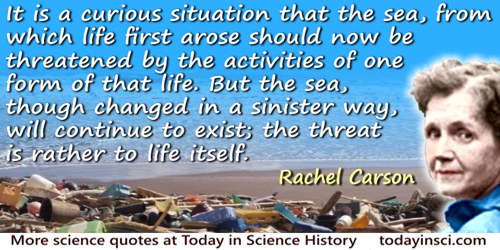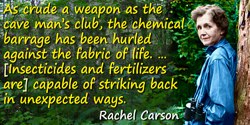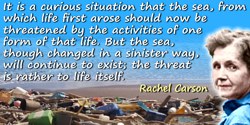Rachel Carson Quotes on Sea (10 quotes)
>> Click for 43 Science Quotes by Rachel Carson
>> Click for Rachel Carson Quotes on | Beauty | Child | Discovery | Earth | Environment | Fact | Insect | Knowledge | Life | Nature | Science | Survival | Tide | Truth | Water | Wonder | World | Year |
>> Click for 43 Science Quotes by Rachel Carson
>> Click for Rachel Carson Quotes on | Beauty | Child | Discovery | Earth | Environment | Fact | Insect | Knowledge | Life | Nature | Science | Survival | Tide | Truth | Water | Wonder | World | Year |
Even in the vast and mysterious reaches of the sea we are brought back to the fundamental truth that nothing lives to itself.
— Rachel Carson
Silent Spring, Introduction.
For all at last return to the sea—to Oceanus, the ocean river, like the ever-flowing stream of time, the beginning of the end.
— Rachel Carson
…...
In Sheldon it was not only the wild creatures [and cats] … that were sacrificed in the campaign against an insect. … Sheep [were in]… a small, untreated blue-grass pasture across a gravel road from a field which had been treated with dieldrin spray…. Evidently some spray had drifted across the road into the pasture, for the sheep began to show symptoms of intoxication almost at once…. They lost interest in food and displayed extreme restlessness, following the pasture fence around and around apparently searching for a way out… [They] bleated almost continuously, and stood with their heads lowered… [Several] sheep eventually died.
— Rachel Carson
In 'Needless Havoc', Silent Spring (1962), 94.
It is a curious situation that the sea, from which life first arose should now be threatened by the activities of one form of that life. But the sea, though changed in a sinister way, will continue to exist; the threat is rather to life itself.
— Rachel Carson
The Sea Around Us (1951).
The birth of a volcanic island is an event marked by prolonged and violent travail; the forces of the earth striving to create, and all the forces of the sea opposing.
— Rachel Carson
In The Sea Around Us (1951), 83.
The edge of the sea is a strange and beautiful place. All through the long history of Earth it has been an area of unrest where waves have broken heavily against the land, where the tides have pressed forward over the continents, receded, and then returned. For no two successive days is the shore line precisely the same. Not only do the tides advance and retreat in their eternal rhythms, but the level of the sea itself is never at rest. It rises or falls as the glaciers melt or grow, as the floor of the deep ocean basins shifts under its increasing load of sediments, or as the Earth’s crust along the continental margins warps up or down in adjustment to strain and tension. Today a little more land may belong to the sea, tomorrow a little less. Always the edge of the sea remains an elusive and indefinable boundary.
— Rachel Carson
Opening paragraph in The Edge of the Sea (1955), 1.
The frillshark has many anatomical features similar to those of the ancient sharks that lived 25 to 30 million years ago. It has too many gills and too few dorsal fins for a modern shark, and its teeth, like those of fossil sharks, are three-pronged and briarlike. Some ichthyologists regard it as a relic derived from very ancient shark ancestors that have died out in the upper waters but, through this single species, are still carrying on their struggle for earthly survival, in the quiet of the deep sea.
— Rachel Carson
In The Sea Around Us (1951), 54.
The winds, the sea, and the moving tides are what they are. If there is wonder and beauty and majesty in them, science will discover these qualities. If they are not there, science cannot create them. If there is poetry in my book about the sea, it is not because I deliberately put it there, but because no one could write truthfully about the sea and leave out the poetry.
— Rachel Carson
Address upon receiving National Book Award at reception, Hotel Commodore, New York (27 Jan 1952). As cited in Linda Lear, Rachel Carson: Witness for Nature (1997), 219. She was referring to her book being recognized, The Sea Around Us.
To stand at the edge of the sea … is to have knowledge of things that are as eternal as any earthly life can be.
— Rachel Carson
In Under the Sea-Wind: A Naturalist’s Picture of Ocean Life (1941), xiii.
When I think of the floor of the deep sea, the single, overwhelming fact that possesses my imagination is the accumulation of sediments.
— Rachel Carson
(1961).
See also:
- 27 May - short biography, births, deaths and events on date of Carson's birth.
- Silent Spring, by Rachel Carson. - book suggestion.
- Booklist for Rachel Carson.





 In science it often happens that scientists say, 'You know that's a really good argument; my position is mistaken,' and then they would actually change their minds and you never hear that old view from them again. They really do it. It doesn't happen as often as it should, because scientists are human and change is sometimes painful. But it happens every day. I cannot recall the last time something like that happened in politics or religion.
(1987) --
In science it often happens that scientists say, 'You know that's a really good argument; my position is mistaken,' and then they would actually change their minds and you never hear that old view from them again. They really do it. It doesn't happen as often as it should, because scientists are human and change is sometimes painful. But it happens every day. I cannot recall the last time something like that happened in politics or religion.
(1987) -- 


